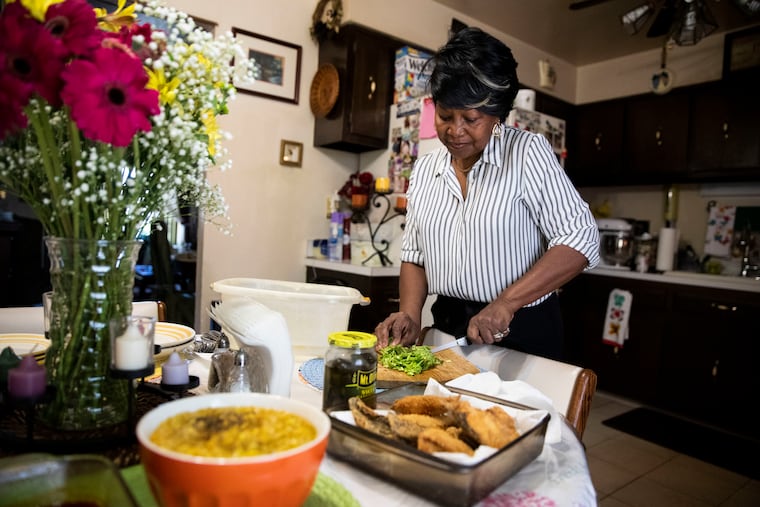Cooks from parts of Africa, the U.S., and the Caribbean share their heritage recipes
The Inquirer asked chefs and home cooks to share recipes with the connections to the African diaspora for Black History Month.

For Brenda Whitfield, the taste of home lives in her Southwest Philadelphia kitchen, her hometown of Mount Olive, N.C., and on the other side of the Atlantic.
When she’s had Nigerian and Liberian food, this 71-year-old grandmother to eight could taste the similarities between the leafy greens and flavors shared with her down-home country style of cooking. Across the diaspora, across the centuries, so much about food has managed to stay the same.
“It still takes us back to our roots, where we come from, our comfort food,” explained Whitfield. “We still value those family roots of sitting at the dinner table. No one can take that away from us.”
In the hopes of having a better taste of the diversity and the connections within the food of the African diaspora, The Inquirer asked chefs and home cooks to share recipes this Black History Month. What’s below is just a sampling, with dishes that trace back to the U.S. South, the Caribbean, and West Africa.
Fried red snapper
Bocar Diop learned to cook during Ramadan. He started cooking for himself around 15. While his parents observed the holiday, he chose not to fast.
“It’s not something you just wake up and know how to do,” said Diop, 27, who is Mauritanian and Senegalese and first moved to Philadelphia in 2009 at 17. “I kept doing it for one month, then one day I got it right.”
Today, he and his father, Abdarahmane Diop, are chefs at his Southwest Philadelphia restaurant, African Small Pot.
“The red snapper is my favorite fish of all time,” Diop said. “When you eat it, you’re going to enjoy yourself.”
Oxtails
Andrea Lawful-Sanders mastered oxtails before they cost this much. Today, with oxtails going for $7 or $8 a pound, she only makes it once a month. But that’s not how it was when she first learned to prepare them in her native Jamaica.
“It was the first full course meal that I ever made that my father loved,” Lawful-Sanders recalled. “I was 9, I’ve been perfecting them ever since.”
John Stanton, a food marketing professor at St. Joseph’s University, said oxtails, like tripe and chicken wings, are ingredients that were once cheap but that markets are now charging more for because they see there’s a demand. The newer demand, which Stanton said has been driven by flavor-curious millennials, has made foods that were once staples for black home cooks really expensive.
“We cooked a bag of oxtails for 99 cents,” Lawful-Sanders said. “I don’t resent the fact that it’s gotten to that place. What it shows me is that we as a people are capable of anything. We took nothing and turned it into a delicacy, period.”
Fried cabbage
“If you have a good meal, you know the family is going to be there,” Brenda Whitfield explained after she prepared baked salmon, fried fish, fried corn, mashed potatoes and beef brisket, corn bread, and sweet potato pie in her Southwest Philadelphia home. Whitfield, 71, hails from Mount Olive, N.C., and believes in cooking the Southern way, even though she moved to Philadelphia in 1968.
As she served her food, she shared some of her tricks: a pinch of baking soda wards off bitterness when making sweet tea and she keeps a tub of seasoned oil similar to lard from North Carolina to use as a fat. While preparing a cabbage grown in a community garden in Southwest Philly on the stove, she explained:
“Back in the day when they boiled it with that big hunk of meat, they took all the flavor out of it,” she said. “But when you fry it? Mmmm!”
Warm Butter Bean Salad with Roasted Bell Peppers
This butter bean salad from chef Bryant Terry’s new vegan cookbook Vegetable Kingdom is modern take on something old school. Terry, a food-justice advocate and chef-in-residence at the Museum of the African Diaspora in San Francisco, said as he researches, he’s found plant-forward food across the diaspora. For this salad, he went back to his childhood.
“I really was just thinking about just the kind of simple foods that my grandparents would often make straight out the garden,” Terry explained. Terry’s grandfather, Andrew Johnson Terry, a Mississippian who moved to Memphis, would raise butter beans in his garden and sauté them. “They brought with them a lot of the agrarian knowledge, and survival instincts, and just this commitment to growing their own food.”
Besitos de Coco
There’s something about the coconut in this recipe, Jessica Van Dop DeJesus explained, that has a way of keeping her in touch with who she is. Van Dop DeJesus was born in Rochester, N.Y., but spent much of her upbringing in Guayama, Puerto Rico, where her retired father would take the time to prepare delicious treats, like papaya candy and these cookies, besitos de coco. The cookies, which are similar to macaroons, are made with brown sugar that caramelizes as it bakes.
“Anything made with coconut reminds me of the coast and where concentrations of Afro-Puerto Ricans are,” said van Dop DeJesus, whose father would make his besitos from fresh coconuts.
“Before, [blackness] was a part of our culture that was shunned, but now it’s something to embrace,” she said, speaking about everything from food to more women wearing their natural hair textures. “It’s tapping into that inherent part of us, which I love.”